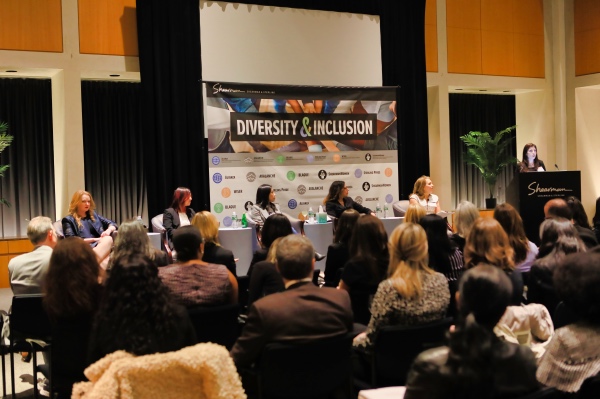
Two Happy Business women outside the office talking to each other.
By Aimee Hansen
You’re not half as good at listening as you think you are.
What’s your first inclination? Dismiss the suggestion? Defend yourself? Conjure up anecdotes supporting just how attentive and caring and compassionate of a listener you truly are?
Would you be proving the accusation true? Most of us aren’t nearly as good of conversationalists as we perceive ourselves to be. In fact, some of the things we think make us great conversationalists might hinder our ability to listen to and support others.
In her book, “We Need to Talk: How To Have Conversations that Matter,” award-winning journalist and author Celeste Headlee, asserts that “conversation may be one of the most fundamental skills we can learn and improve upon.”
Bad communication not only harms our ability to relate to each other. It’s also expensive for business. Cognisco has found that poor communications cost business $37 billion a year.
While good communication, Headlee points out, is profitable: “Companies with leaders who are great communicators have nearly 50 percent higher returns than companies with unexceptional communicators at the helm.”
Here’s a touch of what she highlights in her collection of studies and work and why it matters for relationships of all sorts:
Five ways you might be compromising conversation:
1) You’re not actually having conversations.
Given the choice, over 65% of JPMorgan Chase employees dumped their voice mail in 2015. In 2014, only 6% of Coco-Cola employees kept theirs.
While we’ve culturally shifted to text and e-mails for reasons ranging from speed to control to record-keeping to habit, Headlee writes that research has shown “we are more likely to get our message across through conversation – either in person or on the phone – than we are using a written message.” A 2012 McKinsey study showed that a more selective and intentional use of e-mail would increase productivity by up to 30 percent.
Research summation across 73 studies found that empathy has been in decline over the past thirty years, but especially since 2000. Sitting in front of someone, or hearing the subtle intonations in his or her voice, can build empathy and understanding in a way that bridges gaps and “connects” us again as human beings.
2) You’re keeping your device at the ready.
It turns out that even having a phone on the table during a conversation – regardless of whether you ignore it – has a negative impact on the perception of the connection shared. A British study paired strangers at a table to chat, half the time placing a phone on a nearby table and half the time not. The researchers found that when a cell phone was present in the room (without being touched by either party), the participants reported a lower quality of connection, as well as lower empathy and trust levels for their conversation partner.
We are increasingly lacking real presence in conversations, which mindfulness practices helps us to address.
3) You’re banking on your intellect.
Headlee shares that being smart and articulate doesn’t make you a good conversationalist. In fact, “the smarter you are, the worse you may be.”
“I thought that because I was articulate, I was also good in conversations. But that’s absolutely not true,” Headlee writes. “Being a good talker doesn’t make you a good listener, and being smart might make you a terrible listener.” In fact, it does make you more susceptible to bias.
Headlee says we often fall into what Daniel Kahneman, author of “Thinking, Fast and Slow”, calls System 1 thinking, which is “quick, intuitive, and relies heavily on patterns we’ve learned after years of experience”. It simplifies by relying on assumptions or mental short-cuts, but short-cuts aren’t always right and are often more emotionally reactive than we realize.
She also points out that “a good conversation requires its participants to use their IQ and their EQ.” Too often we meet vulnerability of emotional sharing with a rational response, which does nothing to support someone who is sharing feelings.
Headlee gives the example of a person sharing vulnerably about his pending divorce and you throw out data on the percentage of marriages that end in divorce in an attempt to suggest it’s normal and okay. It doesn’t help provide the emotional support requested.
“Approaching emotional problems with logic is a strategy that is doomed to failure,” Headlee writes. Assuming you get it without really listening can be another.
4) You’re not transparent in expectations.
One of Headlee’s tips is to “explain what you want and what you expect, and be honest.” She asserts that it puts the other person at more ease when we are transparent about what we hope for from a discussion – and it makes you get clearer on that yourself.
She gives this example from her experience: “I’ve called you in to give you an official reprimand. But that’s as severe as this gets. You’re in no danger of being fired. I want to start this discussion by saying how valuable you are to me and the company. My goal is to help you succeed and make you aware of some issues that might be holding you back.”
It’s also important to be transparent with yourself about your own feelings, before you go into conversation, checking in on what you’re really bringing into the talk.
5) You are dropping out at the first hint of disagreement.
“What bothers me is that we don’t talk to each other but at each other,” writes Headlee. “and we usually don’t listen.”
Western countries are becoming unreadily polarized. A 2016 study found that “most Americans now believe people who disagree with one another demonize one another so aggressively that it’s impossible to find common ground.”
This is exasperated by the “halo and horns effect”, she writes: When we approve of one thing about a person, we generally judge everything about them more positively. When we disapprove of something particular, we’re more likely to judge them negatively in many other ways. We all make incorrect assumptions due to bias.
We are less and less willing to connect with people we disagree with, but Headlee asserts, “the need to have difficult conversations has never been greater” and on top of that, “there is no topic so volatile that it can’t be spoken of.”
“Listening to someone doesn’t mean agreeing with them,” she writes. “The purpose of listening is to understand, not to endorse.”
Despite different opinions, we need to bridge through our humanity, being able to empathize with the other person, including cultivating the ability “to see other individuals who face daily challenges that are equal to mine”.
Disagreement can’t be the end of discussion. It needs to be a basis for it.
“It only takes one good conversation to change your understanding of someone else’s world, your world and the world at large,” writes Headlee.
What Makes for Good Conversation?
Headlee raises ten strategies for sharing better conversations, and they all involve taking stock of your role in co-creating the conversation.
One example is becoming aware of our habitual compassion to switch the conversation back into our control and make it about ourselves, even when it seems like we’re “listening” – what Sociologist Charles Derber calls “conversational narcissism”.
In the Huffington Post, Headlee shares how she attempted to comfort a grieving friend by sharing in the experience of losing a father, but actually what she achieved was to turn the conversation around to herself in a way that made her more comfortable with the topic area and detracted from her friend’s pain and need for support in her grief.
Rather than support what the person is saying to us by seeking more insight into their experience, we’ll often shift and relate it back to our own. Because our minds seek convergent information, we’ll scan and find an experience that’s comparable and begin to mentally overlay that on rather than simply listen, which also means we may distort what is being shared with us.
Another behavior we can become aware of is unnecessary and harmful repetition, especially when it comes to negative feedback. Headlee points out that the chances of remembering something increases for you when you repeat it, but not necessarily for the listener. It usually just serves to create aggravation and can even prompt people to lessen their attention.
Those are just a couple examples of many ways we can improve our conversation skills in a profound way.
Overall, thinking we are great listeners or conversationalists doesn’t at all mean we are.
Like many things, however, we can train ourselves to improve through awareness, and dramatically elevate the true quality and effectiveness of the conversations we share.



 “An engineering career can be full of action and excitement,” says Goldman Sachs’ Laura Takacs.
“An engineering career can be full of action and excitement,” says Goldman Sachs’ Laura Takacs.





